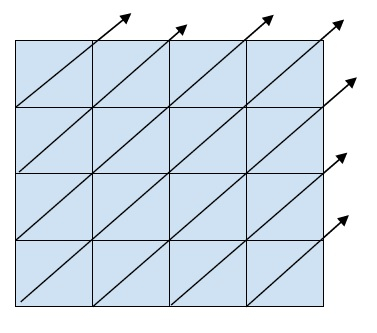
 Data Structure
Data Structure Networking
Networking RDBMS
RDBMS Operating System
Operating System Java
Java MS Excel
MS Excel iOS
iOS HTML
HTML CSS
CSS Android
Android Python
Python C Programming
C Programming C++
C++ C#
C# MongoDB
MongoDB MySQL
MySQL Javascript
Javascript PHP
PHP
- Selected Reading
- UPSC IAS Exams Notes
- Developer's Best Practices
- Questions and Answers
- Effective Resume Writing
- HR Interview Questions
- Computer Glossary
- Who is Who
Zigzag (or diagonal) traversal of Matrix in C++
In this problem, we are given a 2D matrix. Our task is to print all the elements of the matric in a diagonal order.
Let’s take an example to understand the problem,
1 2 3 4 5 6 7 8 9
Output −
1 4 2 7 5 3 8 6 9
Let’s see the pattern that is followed while printing the matrix in a zigzag form or diagonal form.

This is the way diagonal traversal works.
The number of lines in output is always dependent on the row and columns of the 2D matrix.
For a 2D matrix mat[r][c], their will be r+c-1 output lines.
Example
Now, let’s see the solution to the program,
#include <iostream>
using namespace std;
#define R 5
#define C 4
int min2(int a, int b)
{ return (a < b)? a: b; }
int min3(int a, int b, int c)
{ return min2(min2(a, b), c);}
int max(int a, int b)
{ return (a > b)? a: b; }
void printDiagonalMatrix(int matrix[][C]){
for (int line=1; line<=(R + C -1); line++){
int start_col = max(0, line-R);
int count = min3(line, (C-start_col), R);
for (int j=0; j<count; j++)
cout<<matrix[min2(R, line)-j-1][start_col+j]<<"\t";
cout<<endl;
}
}
int main(){
int M[R][C] = {{1, 2, 3, 4},
{5, 6, 7, 8},
{9, 10, 11, 12},
{13, 14, 15, 16},
{17, 18, 19, 20},};
cout<<"The matrix is : \n";
for (int i=0; i< R; i++){
for (int j=0; j<C; j++)
cout<<M[i][j]<<"\t";
cout<<endl;
}
cout<<"\nZigZag (diagnoal) traversal of matrix is :\n";
printDiagonalMatrix(M);
return 0;
}
Output
The matrix is : 1 2 3 4 5 6 7 8 9 10 11 12 13 14 15 16 17 18 19 20 ZigZag (diagonal) traversal of matrix is : 1 5 2 9 6 3 13 10 7 4 17 14 11 8 18 15 12 19 16 20

Advertisements
